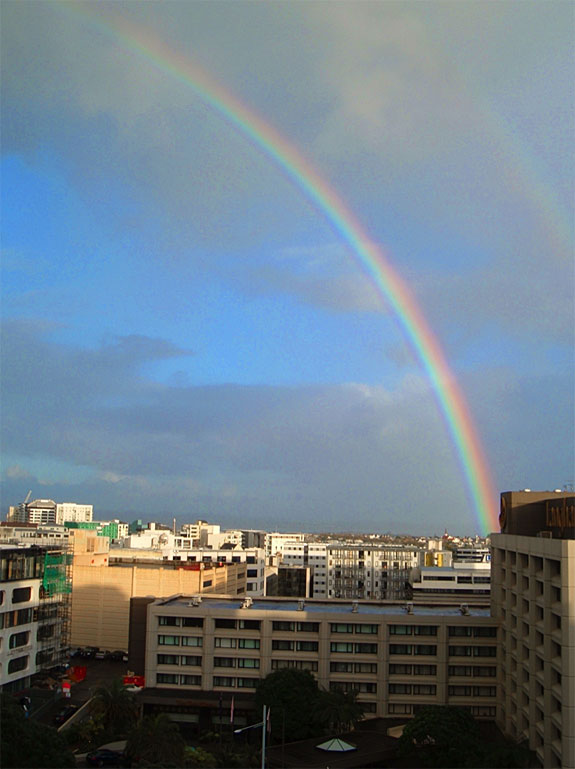PARBICA Conferences
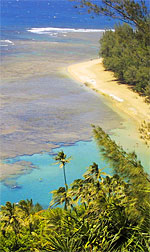
PARBICA 16 REPORT
University of Auckland, New Zealand
September 7-10, 2015
The sixteenth Pacific Regional Branch International Council on Archives (PARBICA), or better known as, PARBICA 16, held its biennial conference from September 7-10, 2015 at the Engineering Building on the campus of the University of Auckland, New Zealand. The conference was held in association with the Archives and Records Association of New Zealand. (ARANZ). The theme of the conference was Footprints in Space and Time, and focused on how record keepers and archivists of the Pacific region must build resilience in a networked society that is changing the way records are created, preserved and used. Archivists and record keepers need to prove their value and better connect communities with their archives and services. A key opportunity for making progress is to form international partnerships and harness the momentum that global initiatives provide.
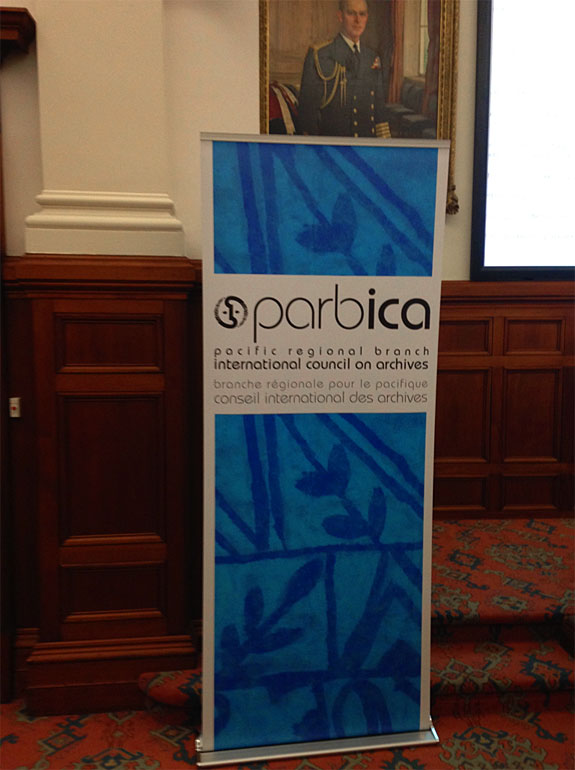
Although the weather was cool and brisk with light showers throughout the week, it certainly did not distract from the wonderful workshops, discussions, and breakout sessions that were offered during the conference. Indeed, the conference attracted more than 150 people from both organizations that work with records in some capacity. Attendees came from Australia, New Zealand, the Pacific Islands, the United States, and even as far as South Africa!
On the first day of the conference two workshops were given to PARBICA attendees. The first took place in the morning, and was presented by Roslyn Russell, an Australian historian and museum specialist. Roslyn is the co-author, with Kylie Winkworth, of the book, Significance 2.0: A guide to assessing the significance of collections (2009), which is the accepted methodology for significance assessment in Australia. She is also a former Chair (2009-2013) of the International Advisory Committee of the UNESCO Memory of the World Program for safeguarding documentary heritage.
The workshop helped participants through the sometime difficult process of assessing the significance of items and collections. Roslyn used the methodology and criteria that was developed in Australia known as Significance 2.0. This method is not meant to compete with or replace well-established collection practices and procedures. Rather, it adds value to current collection practices. The participants learned how the meanings and values of archival collections could be best understood and evaluated through this process. They also learned how to apply the significance criteria to their own collections, and how significance assessment can benefit their institutions. Finally, the workshop featured case studies of significance assessments of archival collections from Australia and the Pacific region.
The second workshop dealt with Disaster Preparedness and took place in the afternoon in two separate parts. The participants were split into two groups. One group sat in the conference room for the Creating an Affordable Disaster Management Strategy workshop, while the other group went outdoors to engage in the Salvaging Water-logged Materials workshop. Then, after about an hour and a half, the two groups swapped places.
Cheryl Jackson of the Australia National Archives presented the Creating an Affordable Disaster Management Strategy workshop. It was designed for participants to learn how to set up their storage and display areas away from water leaks, as well as learning how to block up mouse holes. The workshop also taught participants how to train staff and contractors the basic steps to avoid damage to their collection. Perhaps, the most significant portion of the discussion took participants through the basic, affordable strategies for preventing disasters, and preparing for ones that do happen.
Exposure to water is one of the most common ways archival records can become damaged after a minor or major disaster, especially in the Pacific Islands region. Thus, the second part of the Disaster Preparedness workshop dealt with the recovery process of water logged materials. Brandon Oswald of the non-profit organization, Island Culture Archival Support, presented this workshop. This practical hands-on experience concentrated on the last two stages of the recovery plan: the initial response and the recovery efforts. Although it was not advocated to do your recovery response outdoors (only in extreme circumstances), the group simply took advantage of the beautiful day in Auckland. Plus, since water was being used, it was a good idea to have the workshop outdoors.
The practical hands-on workshop allowed participants to focus on becoming familiar with the air-drying process of archival record. Five plastic bins were filled halfway with water. Then, records were placed in each bin. These included books, maps, documents, photographs, and some media materials like microfilm, microfiche and VHS tapes. Participants worked in groups of three to five and began pulling the material out of the bin, placing them on blotting paper, and began the process of air-drying. Each record required a different drying technique, and we went through each one. It was hoped that participants got a sense of what wet material feel likes, and how to apply the different tricks that can help save space and time.
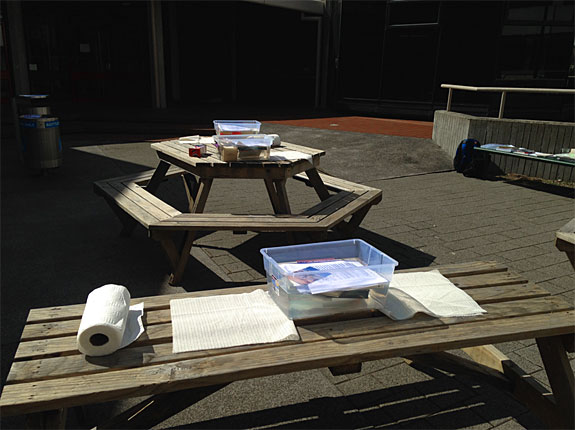
Hopefully, the participants will never, ever have to salvage water logged material. However, the Pacific Islands are in very volatile part of the world. Cyclones, especially, seem to be occurring more often than ever before bringing destruction to the tiny islands that dot the Pacific Ocean. Thus, it was vital that the participants during this workshop learned the appropriate handling techniques, and became familiar with the different response supplies and resources that are needed during the recovery process.
Tuesday marked the first day of the joint conference between ARANZ and PARBICA. It opened with a powhiri- a Maori welcoming ceremony involving speeches, dancing, singing and finally the hongi. Like a handshake, the hongi is the traditional Maori greeting where two people touch noses. After the ceremony, the first of two keynote speakers, took to the podium. This was Anne Gilliand who is the Director of Information Studies and Moving Image Archive Studies at the University of California, Los Angeles. The title of her talk was, Preamble Binaries and the 21st Century Record. It explored records production, deployment, interpretation and affect by proposing three interrelated permeable binaries- actualized/imaginary, instantiated/latent, and enduring/transitory. It was heavy, sobering stuff. The talk made the audience think about archives in whole new light.
After the keynote speaker’s speech, the participants broke-out into parallel sessions. In fact, this was the routine for the rest of the day. This is where the conference gets a little tough because there might be two interesting sessions occurring at the same time, and you can only chose one. One of the more popular and interesting sessions was Partnerships and Collaboration: A Powerful Tool for Developing Archives by Opeta Alefaio of the Fiji National Archives and Andrew Martin of DAMSmart. Another important talk was Mark Crookston of the Alexander Turnbull Library, New Zealand, and Kylie Moloney of the Pacific Manuscript Bureau. Both of these speakers talked about their organizations and their most recent projects.
Wednesday started off with another hard-hitting keynote speech. This time it was delivered by Verne Harris who is the Director of Research and Archive at the Nelson Mandela Foundation in South Africa. The title of his paper was Footprints of Ghosts and Bandits, and was quite the spellbinding talk. Harris explored the spectral dimensions of archival work, particularly in the contexts of digital record making. He addressed his primary concerns of the conference theme along three lines of inquiry: the absences which haunt even the most densely documented transactions and process; the weight of traumatic pasts; and the call of justice in a world increasingly defined by structural inequality and the specter of climate change. He posits the need for “archival banditry” in rising to these challenges. It was a fascinating talk, easily capturing the attention and imagination of the audience.
The rest of the morning was much like that of the day before with parallel sessions. Once again, choices were tough to make, but that is how it usually is at a good conference. Top marks go to the Digital Footprints session where, first, Cheryl Jackson of the National Archives Australia talked about creating and maintaining digital photographs. Then, Lupe Silulu of the Secretariat of the Pacific Regional Environment Program spoke about the issues of her archives. And finally, Dave Sanderson of the Auckland War Memorial Museum had an informative discussion on digitization and publication tips and tricks for digital collections.
In the afternoon the main spotlight was shining on another workshop regarding the ICA AtoM, and was presented by Anna Monson of the National Archives New Zealand. The ICA-AtoM is a web-based archival description software that is based on the International Council on Archives (ICA) standards. The workshop focused on developing a case study and proof of concept for the basic implementation of ICA-AtoM in a Pacific Island country. The purpose of the workshop was to explore the feasibility of implementing the software in more detail and investigate how best this could be supported by a potential funding bid. The overall aim was to create a methodology for implementing the ICA-AtoM that can be used, developed and ultimately adopted by other organizations within the Pacific Islands. This was a timely workshop, as many of the institutions have not yet implemented a descriptive database for their archival collections.
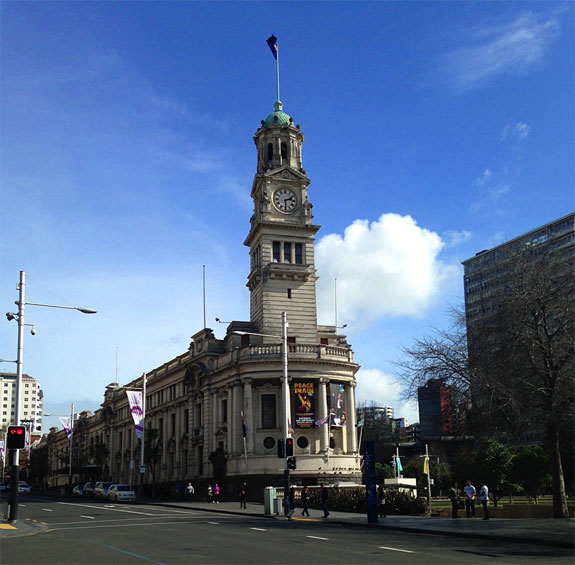
On Thursday we said goodbye to the ARANZ participants and had our general PARBICA meeting at the Council Chamber of the Auckland Town Hall that was right in the middle of town. The hall opened in 1911, and is considered a highly protected heritage place in New Zealand. It is still used for administrative functions such as the city’s council meetings and hearings. The PARBICA general meeting is typically the last source of business for the group. It was opened, like most meetings, with the assessment of quorum, adoption of the agenda, and the confirmation of the minutes taken from the last PARBICA general conference. After this, the meeting moved to the activities of PARBICA that took place between 2013-2015 such as the President’s, Secretary, Treasurer, and Communications reports. Other important meeting agenda items included the proposed amendments to the PARBICA constitution, the discussion on and adoption of resolutions of PARBICA 16, and the current developments of Pacific Islands’ roundtable. The meeting adjourned around noon, and everyone bid farewell until we meet again in 2017.
All in all, the rich and diverse programs and workshops of the joint conference was truly an unique, and informative experience. Footprints in Space and Time was a timely, relevant theme, as many of the papers and discussions were well suited to the interests of the attendees, especially those from the Pacific Islands. The theme truly reflected that in a networked society, the way records or footprints are being created, preserved and shared is changing, with implications for human rights to information and privacy. Auckland’s chilly and rainy backdrop was a bit different than the usual PARBICA host city it has had over the years. Nevertheless, it did not dampen the opportunities of making new relationships while renewing old ones.
